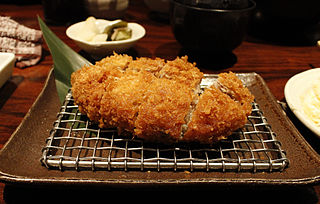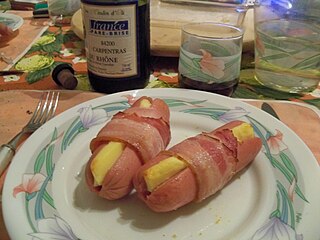
Frankfurt am Main is the most populous city in the German state of Hesse. Its 773,068 inhabitants as of 2022 make it the fifth-most populous city in Germany. Located in the foreland of the Taunus on its namesake Main, it forms a continuous conurbation with Offenbach am Main; its urban area has a population of over 2.7 million. The city is the heart of the larger Rhine-Main metropolitan region, which has a population of more than 5.8 million and is Germany's second-largest metropolitan region after the Rhine-Ruhr region and the fourth biggest metropolitan region by GDP in the European Union. Frankfurt is home to the European Central Bank, one of the institutional seats of the European Union, while Frankfurt's central business district lies about 90 km (56 mi) northwest of the geographic center of the EU at Gadheim in Lower Franconia. Like France and Franconia, the city is named after the Franks. Frankfurt is the largest city in the Rhenish Franconian dialect area.

Tonkatsu is a Japanese dish that consists of a breaded, deep-fried pork cutlet. It involves coating slices of pork with panko, and then frying them in oil. The two main types are fillet and loin. Tonkatsu is also the basis of other dishes such as katsukarē and katsudon.

Sauerkraut is finely cut raw cabbage that has been fermented by various lactic acid bacteria. It has a long shelf life and a distinctive sour flavor, both of which result from the lactic acid formed when the bacteria ferment the sugars in the cabbage leaves.

Polish cuisine is a style of food preparation originating in and widely popular in Poland. Due to Poland's history, Polish cuisine has evolved over the centuries to be very eclectic, and shares many similarities with other national cuisines. Polish cooking in other cultures is often referred to as à la polonaise.

Schnitzel is a thin slice of meat. The meat is usually thinned by pounding with a meat tenderizer. Most commonly, the meat is breaded before frying. Breaded schnitzel is popular in many countries and is made using veal, pork, chicken, mutton, beef, or turkey. Schnitzel originated as wiener schnitzel and is very similar to other breaded meat dishes.

Ukrainian cuisine is the collection of the various cooking traditions of the people of Ukraine, one of the largest and most populous European countries. It is heavily influenced by the rich dark soil from which its ingredients come, and often involves many components. Traditional Ukrainian dishes often experience a complex heating process – "at first they are fried or boiled, and then stewed or baked. This is the most distinctive feature of Ukrainian cuisine".

A ham hock or pork knuckle is the joint between the tibia/fibula and the metatarsals of the foot of a pig, where the foot was attached to the hog's leg. It is the portion of the leg that is neither part of the ham proper nor the ankle or foot (trotter), but rather the extreme shank end of the leg bone.

Eisbein is a German culinary dish of corned ham hock, usually cured and slightly boiled. The German-language name has associations with the practice of using a pig's leg-bone for ice skating. In southern parts of Germany, the common preparation is known as Schweinshaxe, and it is usually roasted. The Polish dish golonka, '(little shin)' or golonko and the Swedish dish fläsklägg med rotmos are very similar, alternatively grilled on a barbecue; other similar dishes include the Swiss Wädli and the Austrian Stelze.
Soup beans is a term common in the Southern United States, particularly the regions around the Appalachian Mountains. Soup beans are usually served with cornbread, greens, and potatoes and may be topped with raw chopped onions or ramps. Soup beans are considered a main course, but also serve as a side dish. In rural areas, where food was scarce during the winter, these dried beans were a staple food.

Zasmażana kapusta, known to many Polish people simply as kapusta [kah-POOS-tah], is a Polish dish of braised or stewed sauerkraut or cabbage, with bacon, mushroom and onion or garlic. It is seasoned with salt, pepper and sometimes bay leaf, caraway seeds, sugar, paprika and apples. The traditional dish is usually served along with boiled potatoes as an accompaniment for pork chops, pork cutlets, other pork dishes, veal, or game meats. In some homes, kapusta is served very thin, almost like a soup. In others, its ingredients are thickened with flour or cooked until it becomes nearly as thick as mashed potatoes. It has been described as less sour in flavor compared to German sauerkraut.
Luxembourg's cuisine reflects the country's position between the Latin and Germanic countries, influenced by the cuisines of neighbouring France, Belgium and Germany. Recently, it has been influenced by the country's many Italian and Portuguese immigrants. As in Germany, most traditional, everyday Luxembourg dishes are of peasant origin, in contrast to the more sophisticated French fare.

Wiener schnitzel, sometimes spelled Wienerschnitzel, is a type of schnitzel made of a thin, breaded, pan-fried veal cutlet served without sauce.

Schäufele is a traditional dish from Franconia in the south of Germany. It is made from the pig's shoulder meat, which gives the dish its name, "Schäufele", or the pig's scapula.

A Frankfurter Würstchen is a thin parboiled sausage in a casing of sheep's intestine. The flavour is acquired by a method of low temperature smoking. For consumption, Frankfurters are occasionally not boiled; they are heated in hot water for only about eight minutes to prevent the skin from bursting. They are also commonly grilled over propane or charcoal flame. They are traditionally served with bread, mustard, horseradish and/or potato salad.

Breaded cutlet or braised cutlet is a dish made from coating a cutlet of meat with breading or batter and either frying or baking it.

Alsatian cuisine, the cuisine of the Alsace region of France, incorporates Germanic culinary traditions and is marked by the use of pork in various forms. The region is also known for its wine and beer.














